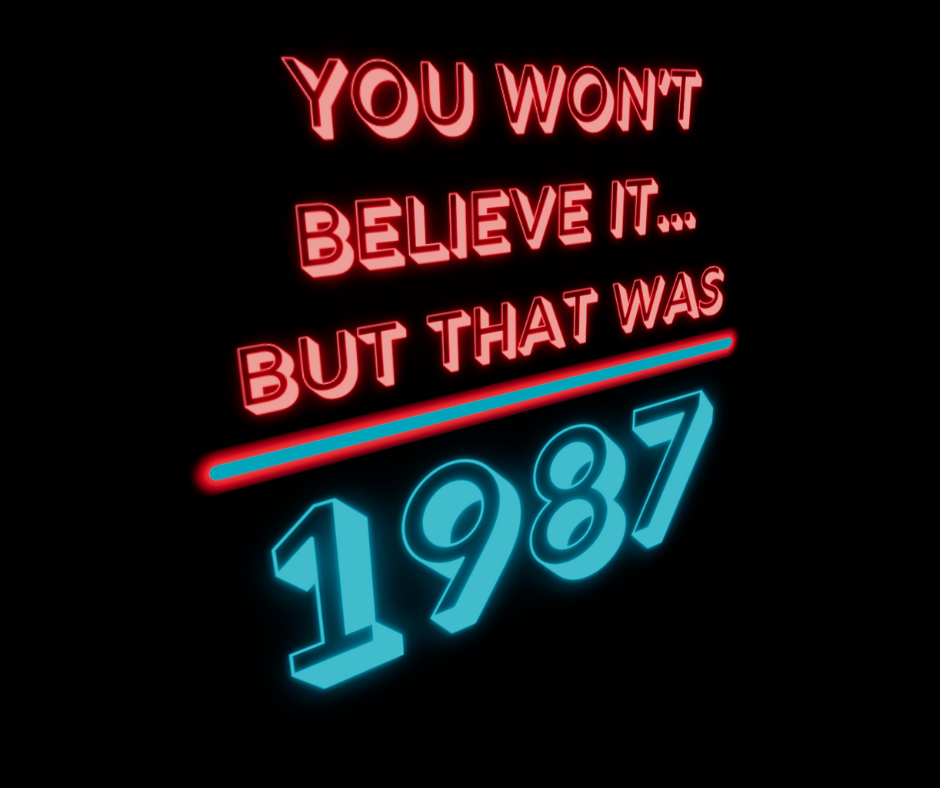
In 1987, the UK music scene was bursting with energy and diversity. Pop, rock, new wave, and the budding seeds of hip-hop were all making waves. This wasn’t just a great year for chart-toppers; it reflected the evolving tastes of the British public and a world hungry for fresh sounds.
I spent all of 1987 at Shrewsbury Sixth Form College, so as a matter of course I would be able to pop into town to peruse the local record shops. All told, I bought 34 singles, either on 7-inch or 12-inch.
Jumping on the bus home at the end of the day, the anticipation was palpable. The thrill of going home with new music was tangible. I was mad keen on each and every single one of them at the time.
Perhaps looking back now, I might be feeling a little less convinced of some of my purchases. For some bizarre reason, I bought one track on both 7-inch and 12-inch. Edgy, huh?
With all that said, 1987 was another exciting year for music in the British singles chart. There is also a niggling feeling that it represents a bit of a high water mark for those charts.
I’m sorry, not sorry, to single anybody out. However, this year, as we consider the best-selling singles, you can see the ominous hand of a certain trio of producers.
But that’s enough highfalutin’ speak from me. Even my collection has stuff from those guys in it. Isn’t it interesting what the distance of almost 40 years does to one’s musical tastes? What’s not in doubt is that these records are a treasure trove, a proper historical cache which is not wholly dependent upon the quality of the music imprinted on them.
So, without further ado, let’s take a nostalgic spin through 1987. Let’s see if we can work out what attracted me to them.
Top-Selling UK Singles of 1987: A Record-Breaking Year
Before the deep dive into my collection, here’s a nod to those singles that sold the most copies. Some unforgettable singles took the UK charts by storm. Each one told a story, dominated radio waves, and had everybody up on their feet. Here are the five top-selling tracks over the year.
Rick Astley’s Never Gonna Give You Up
This was the top-selling single and, from 2024 at least, it’s impossible not to smile thinking about this one. Astley’s smooth vocals and that catchy chorus made it an instant hit. By 1987, I thought I was above this sort of stuff – at least that’s what I say in polite conversation. I didn’t buy this, but there are other items lurking in my collection that are, so to speak, cut from the same cloth.
Starship’s Nothing’s Gonna Stop Us Now
Starship was an American group from San Francisco. It emerged as a continuation of Jefferson Starship. In turn, this was a continuation after the late 60s / early 70s band Jefferson Airplane. The band’s musical direction changed, as did the personnel. This lead to a name change following a lawsuit settlement. Perhaps the most famous constant member was singer Grace Slick.
Starship’s first single We Built This City reached the respectable position of number 12 in the UK singles chart in 1985. Sara, the follow-up, fared less well. It only reached number 66.
Nothing’s Gonna Stop Us Now is an emotional ballad, tugging at the heartstrings. It was also an anthem of optimism. It spent 9 weeks in the top ten of the UK singles chart. 4 of those weeks were at number 1. The theme to the 1987 feature film Mannequin, it struck a chord with many and cemented its place in pop culture.
Whitney Houston’s I Wanna Dance With Somebody (Who Loves Me)
This is pure joy captured on a black plastic disc with a central hole. Houston’s powerhouse voice made this track an exhilarating call to the dance floor. It’s a bop that’s still loved at parties and weddings.
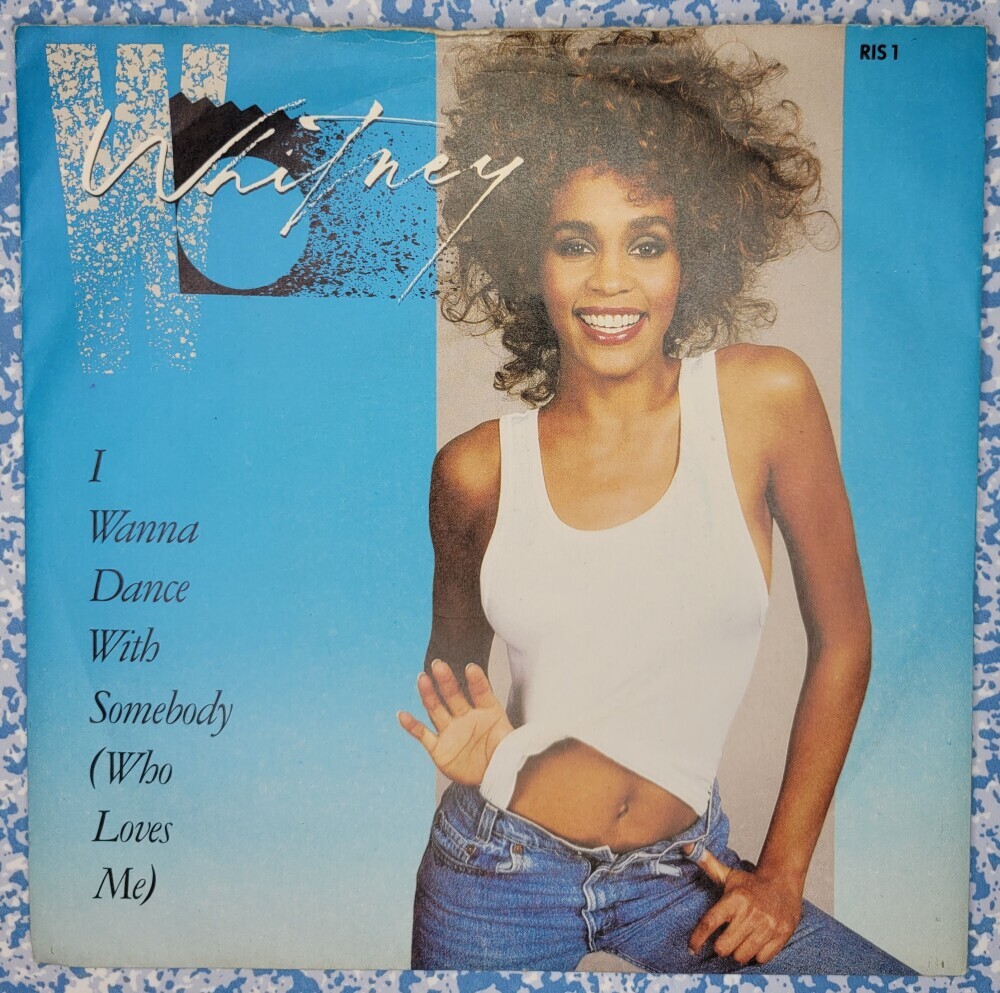
It reached number 1 in the UK singles chart in June 1987, spending 2 weeks there. In all, it spent 8 weeks in the top ten. Because it was just so joyous, I bought it on 29 May 1987.
In quite the departure, Dad asked me to buy Whitney, the album that the track came from. Now, as you know, parents are not supposed to like the music their offspring like. To be fair to him, most of the time, Dad did grumble through Top Of The Pops pretty convincingly.
You Win Again by the Bee Gees
This Autumnal hit was written and performed by the three brothers, Barry, Robin and Maurice Gibb. In reaching number 1, where it spent 4 weeks, the Bee Gees became the first act to score a UK singles chart number 1 in each of the three decades – the sixties, seventies and eighties.
In many ways, the Bee Gees have been underrated over the years. Perhaps the backlash against disco caught them in its wake. But they were so much more than just a disco group. This track showed their versatility and ability to evolve with the times.
Even in the late 80s, they were still crafting hits that listeners loved, blending their signature harmonies with fresh production.
T’Pau’s China In Your Hand
The fifth best-selling single in the UK for 1987 was this track from Shropshire’s very own T’Pau. Talk about degrees of separation. Here was a group from my home county who were named after a Vulcan diplomat in the hit US sci-fi series Star Trek.
Furthermore, China In Your Hand was inspired by Mary Shelley’s Frankenstein – perhaps the original work of sci-fi. It’s a power ballad and it showcased Carol Decker’s commanding vocals and had an epic touch that made it memorable.
It reached number 1 in November and spent 5 weeks there in the run up to Christmas. Sales were not strong enough to maintain the number 1 spot for ever though. Consequently, it dropped to number 5. Pet Shop Boys with their cover of Always On My Mind took the title of the UK’s Christmas number 1 for 1987.
The Singles I Bought in 1987
So, there is my nod to those singles that sold a ton of copies in 1987. But what about the singles that made their way into my collection of nearly 40 – all on a paperboy’s wages? Each one had its own vibe, its own story, and most of them still hold a special place in my heart. Let’s get started.
Beastie Boys’ (You Gotta) Fight For Your Right (To Party)
(You Gotta) Fight For Your Right (To Party) by Beastie Boys is a high-energy track that blends rock and hip-hop elements. It’s a rebellious anthem that screams defiance. This vibe is primarily created by its driving guitar riff, pounding drums, and catchy chorus.
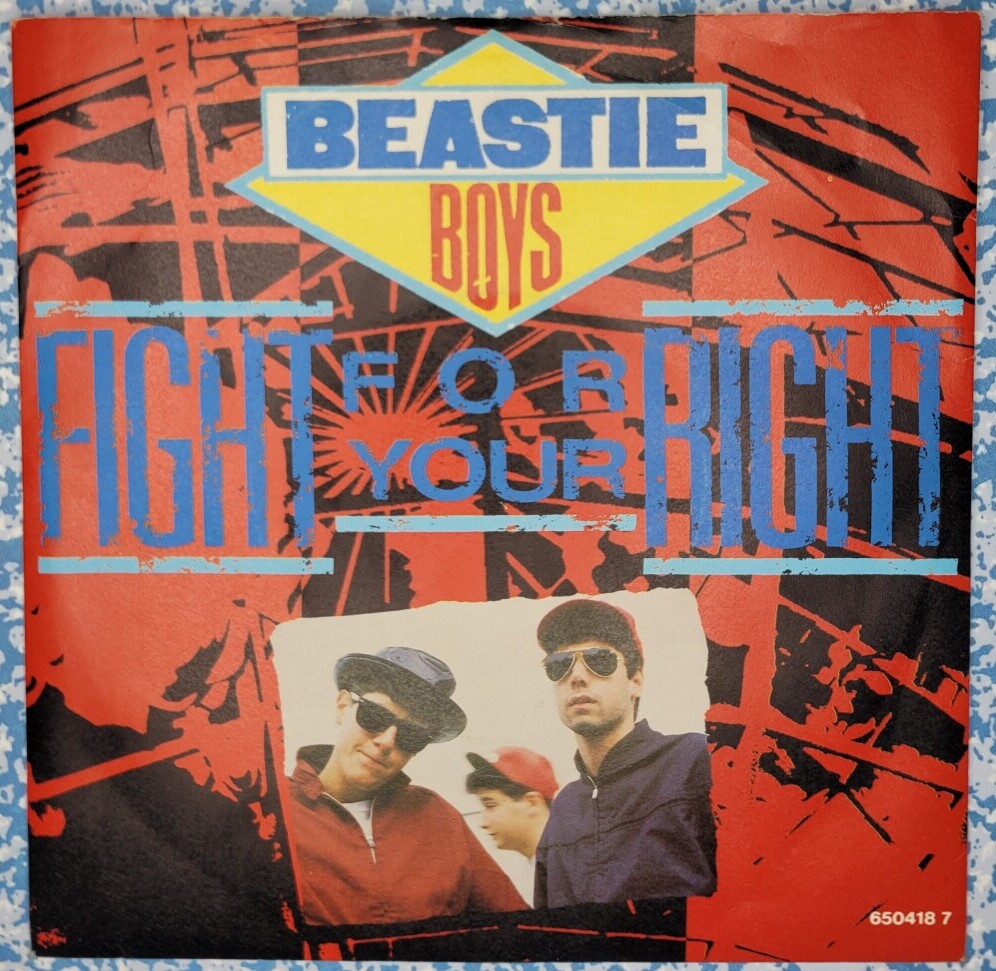
The song’s production emphasizes a raw, party-like atmosphere, reflecting its carefree spirit. It satirises the stereotypical teenage rebellion and the desire for freedom. It has great humour and uses irony to critique societal norms and parental authority.
The track’s message, while seemingly advocating for partying, ultimately highlights the absurdity of youthful defiance, making it both entertaining and thought-provoking. The take on Dad’s hypocrisy over the subject of smoking is typical. If these kids properly understood where Dad was coming from, they would know he is regretful that he smokes. He wishes, not only that he didn’t smoke, but that his son(s) will not start.
Black – Sweetest Smile
This melancholic ballad showcases Colin Vearncombe’s wide-ranging voice. The song’s musicality is marked by its gentle piano and string arrangements, creating a sombre yet beautiful atmosphere.
Lyrically, it delves into themes of loss and longing, capturing the bittersweet nature of reminiscing about happier times. Love sure is complex of love and the pain of separation intense. It is a sincere and heartfelt exploration of emotional vulnerability.
I bought the 12-inch version on 24 July – it was probably an end-of-term present to myself.
Black – Wonderful Life
Wonderful Life is an iconic track known for its uplifting yet inward-looking tone. Musically, it features a smooth blend of pop and jazz influences, with a memorable melody and Vearncombe’s rich vocals.
Influenced by his unpleasant divorce, the lyrics convey a message of hope and resilience, encouraging listeners to find beauty and meaning in everyday life despite challenges. It has an optimistic outlook, balanced by a sense of realism. It is an inspirational track and a timeless anthem, offering solace in the face of adversity.
Wonderful Life was initially released on Ugly Man Records in September 1986. It stuttered to number 72 before disappearing. All was not lost though, as A&M had noticed Vearncombe. After signing with them, he found top-ten success with Sweetest Smile.
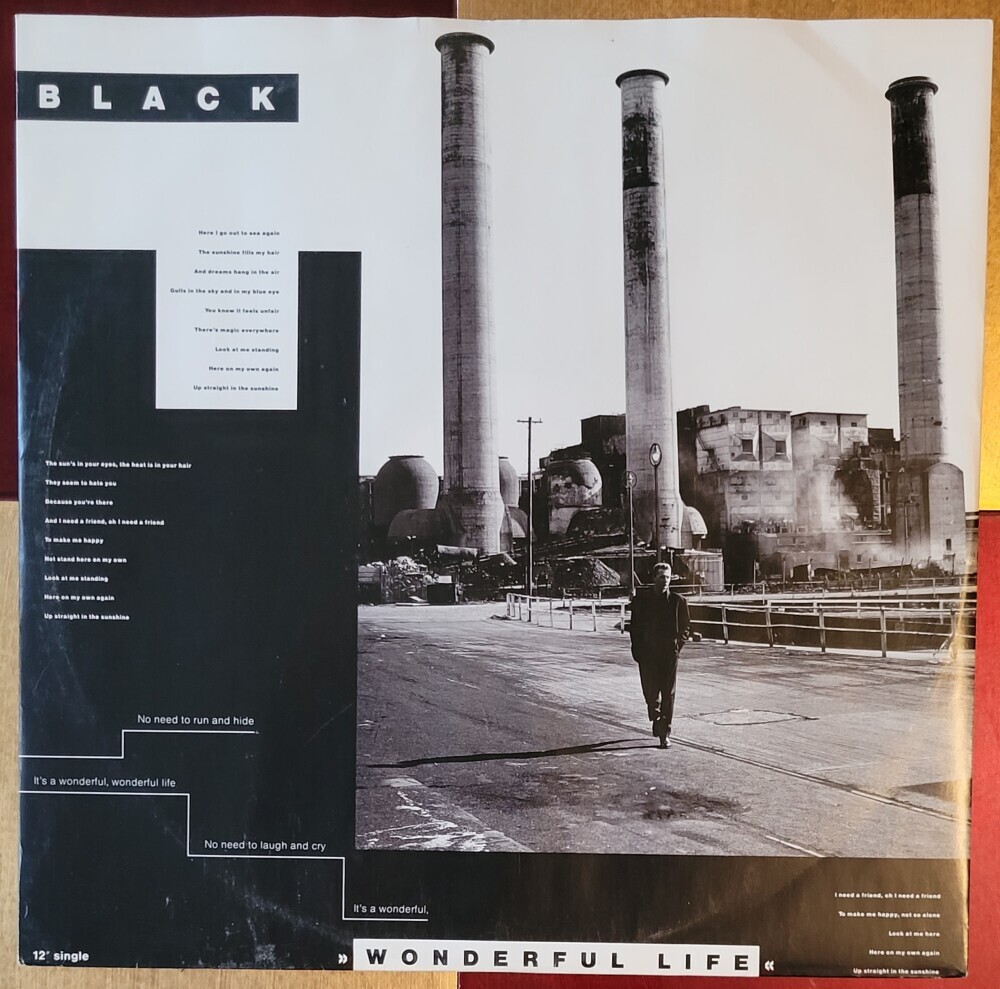
Then, Wonderful Life was re-released, and it followed its predecessor into the top ten. To my eternal shame, I missed it in 1986. Now caught up, having bought Sweetest Smile, I was ready for this. I bought my 12-inch copy on 12 September – probably a back-to-college present.
Belinda Carlisle – Heaven Is A Place On Earth
More 12-inch delight with this one. It’s a proper feel-good rocker, a vibrant pop anthem, from the former lead singer of the Go-Go’s. Its chorus is catchy and its tempo upbeat. The song is driven by energetic guitar riffs and synths.
Lyrically, it celebrates the joy and fulfilment found in love, portraying a romantic relationship as a source of happiness and contentment. It is a message of optimism and positivity, capturing the euphoria of being in love and the belief that paradise can be found in the here and now.
The Christians – Forgotten Town
Forgotten Town is a socially conscious track that combines soulful melodies with thought-provoking lyrics. Musically, it features rich harmonies and a blend of pop and soul influences, creating a smooth and engaging sound. Garry Christian says that they “mix[ed] the harmonies of Motown and gospel with the 80s synth that was going on at the time.”
The lyrics address themes of neglect and urban decay, highlighting the struggles faced by communities left behind by progress. The song’s message is one of awareness and empathy, urging listeners to consider the plight of those living in forgotten areas and to reflect on the broader social issues at play.
Just Like Heaven by The Cure
You know when a song gets hold of you and won’t let go? Well, here’s one. I had always been keen on The Cure, but apart from 1985’s twin singles Inbetween Days and Close To Me I’d not actually bought any of their singles or albums.
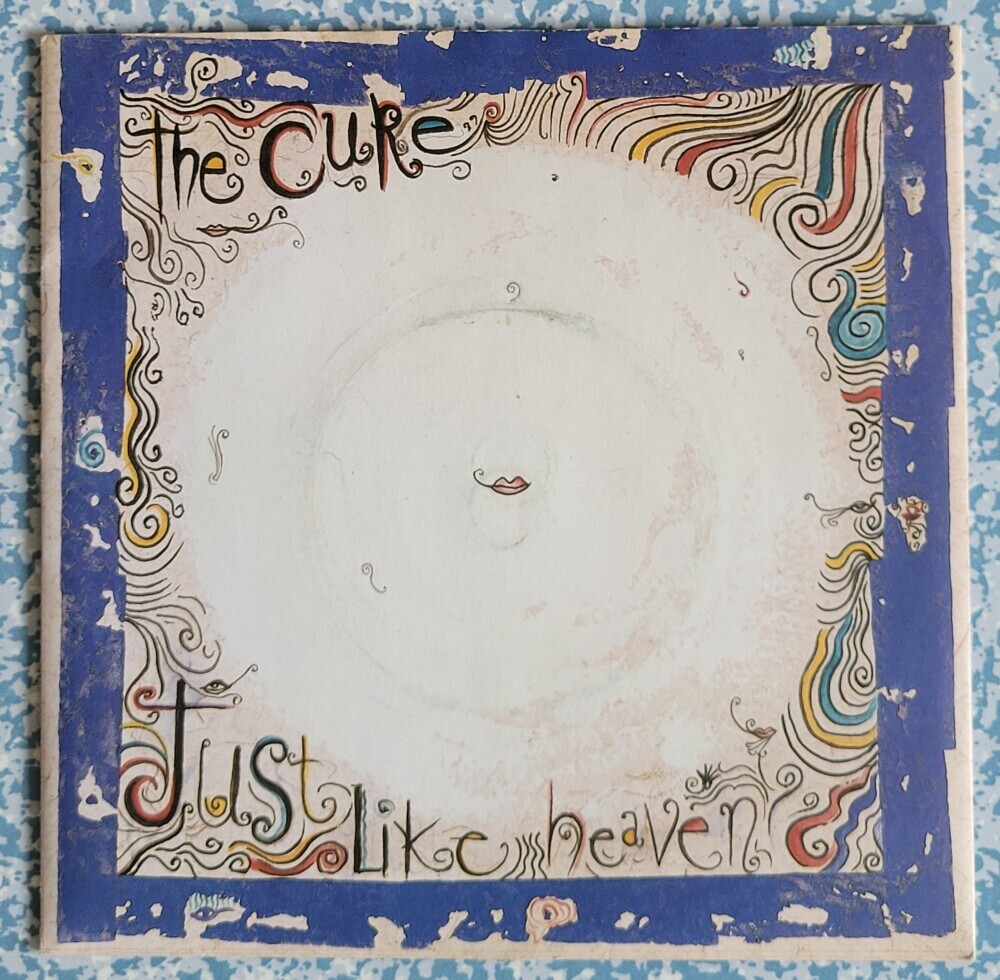
Then in 1986 they remixed and re-voiced their 1979 single Boys Don’t Cry. It must have penetrated my thick skull, but not enough to make me go and buy it. So, we moved into 1987, and two more singles came and went before this utter peach caught my ear.
If a song which starts with a drum fill such as this can be dreamy and melancholic, then this is dreamy and melancholic. Robert Smith’s voice, combined with that lush instrumental backdrop, makes it a perfect tune. It’s a timeless piece that still hits home.
Robert Smith and company knew how to tug at the heartstrings, making this a go-to for those quieter, reflective moments.
Terence Trent D’Arby’s If You Let Me Stay
Some tracks in my collection, notably Peter Gabriel’s Sledgehammer and Eurythmics’ Thorn In My Side, have that unique ability to grab you by the scruff of the neck the minute the needle hits the vinyl. This track sits comfortably in that company.
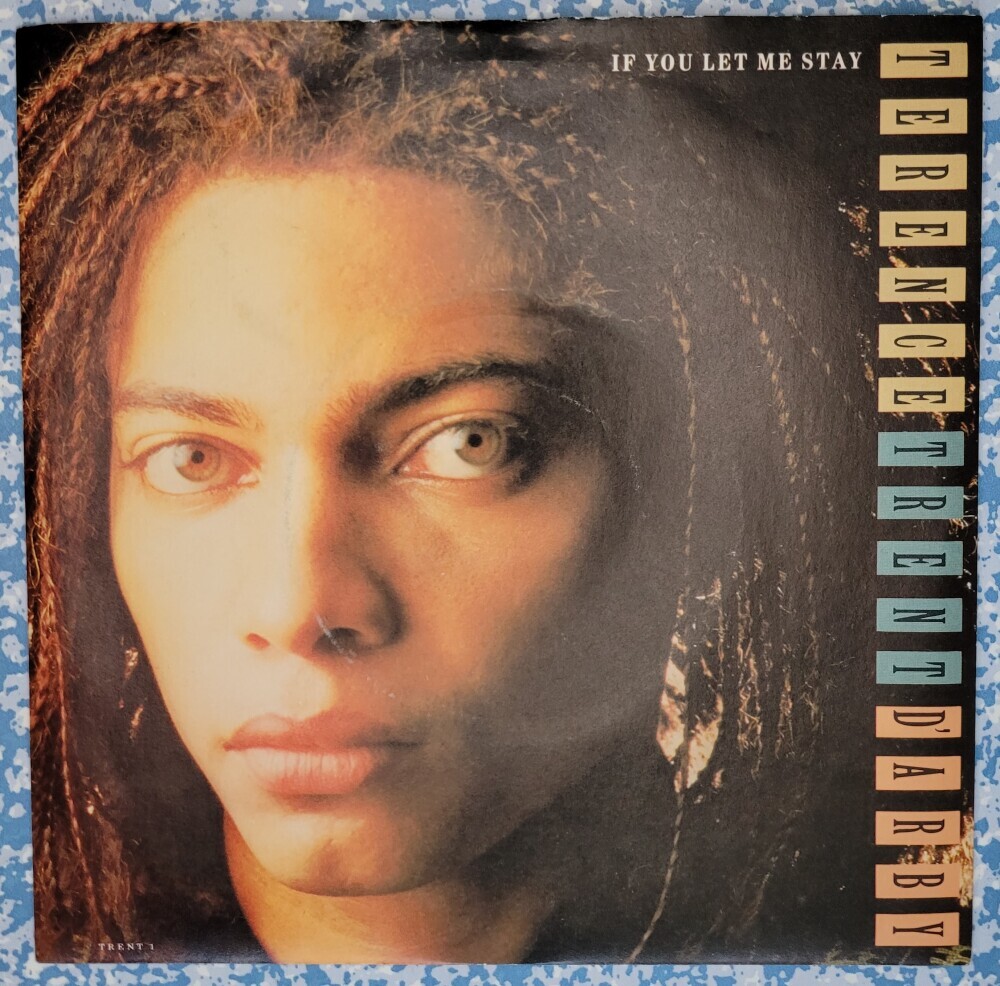
With his powerful vocals, D’Arby delivers a blend of rock, pop, and R&B that was truly refreshing. It’s one of those songs that’s hard to skip. And it certainly added a bit of soul to my collection.
I bought it on 24 April 1987. It was a Friday, so I am presuming that I would have bought it at lunchtime. A sop to the double A Level maths that I endured on those Friday afternoons.
If You Let Me Stay was a very strong performer in the UK singles chart. It reached a high position of number 7 and spent three weeks there.
Erasure – Live In Hamburg (Disc 3 of 3 The Circus – Gladiator Mix)
I bought this 12-inch single without realising that I had got my hands on the third part of a limited edition 12-inch single set. The set was in support of the group’s seventh single, The Circus. It was also released on 7-inch.
In addition to the Gladiator Mix of The Circus, this one has three live tracks – Sometimes, Say What, and Oh L’amour. The first of the three 12-inch singles has 4 live tracks – Victim of Love, If I Could, The Circus, and Spiralling.
The second 12-inch has three live tracks – It Doesn’t Have to Be, Who Needs Love Like That, and Gimme! Gimme! Gimme! (A Man After Midnight), plus the Bareback Rider Mx of The Circus. All the live tracks were recorded at Knopf’s Music Hall in Hamburg.
The Gladiator Mix adds a dynamic layer to the original track, emphasising its danceable elements and Clarke’s vibrant electronic elements. Lyrically, it’s about societal pressure and the struggle for individuality. It’s metaphorical with the circus depicting the challenges of modern life. The three live performances give us the essence of Erasure’s engaging stage presence.
Let It Be by Ferry Aid
On 6 March 1987, the Townsend Thorsen ferry MS Herald of Free Enterprise capsized within 90 seconds of leaving the Belgian port of Zeebrugge bound for Dover. A total of 193 passengers and crew died as a result.
Ferry Aid’s single Let It Be, then, was a response to the tragedy by the great and the good. There was also an element of guilt on the part of the S*n newspaper as it had sold cheap tickets for the ferry on that day. Maybe guilt is the wrong word, but it certainly showed the S*n up for the opportunistic scummy rag that it is. And don’t mention the then editor.
Anyway, this is supposed to be about the music. Let It Be is, of course, a Beatles classic. The S*n‘s Gary Bushell initially organised the recording. He then recruited Stock, Aitken and Waterman to produce the track. Initial invitations to join in on the track met with lukewarm responses, but eventually, the likes of Mark King, Paul King, Mark Knopfler, Boy George, Kate Bush and a host of others agreed to take part.
Interestingly, Chumbawamba, released a parody. Called Scab Aid, it mercilessly lampooned the stars who joined in on Ferry Aid. Maybe they should have stuck by their initial reluctance. However, I bought the bloody thing. I paid good money to add the disc to my collection.
At this time, I was still delivering newspapers to earn my money for records. Amongst others, one of the titles I pushed through letter boxes was the S*n. I’d often have a cheeky peek at things – usually football, and, ahem, other features.
At seventeen, I was not a man of the world. I did not grasp quite what a nasty piece of work the rag was/is. Buying the single then, was a response more to the opportunity to buy music with, for example, Paul McCartney performing on it. Does that sound plausible? I hope so.
Fine Young Cannibals’ Ever Fallen in Love
I really wanted to be a punk rocker. Tracks like this, originally from the halcyon days of punk rock, were therefore right up my street. In truth, I probably did not realise that this was a cover much less that it was written and originally performed by the Buzzcocks.
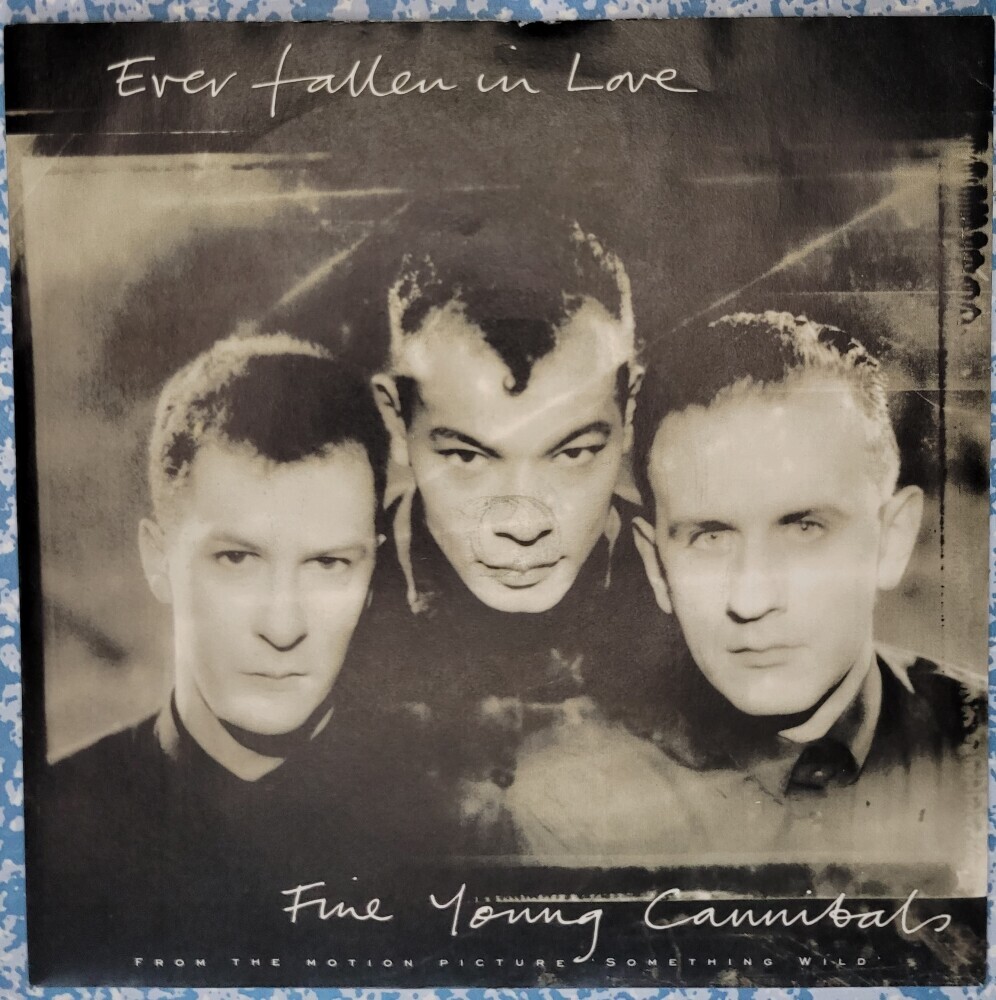
Fine Young Cannibals were pretty bloody cool back then though, so this was a natural fit in my record collection. They brought a quirky energy with their unique sound. They weren’t afraid to mix things up, and this track was a testament to their innovative approach to music. This afforded them yet another top-ten hit in the UK singles chart.
I bought my copy on 18 April 1987. I had been to Gay Meadow to watch Shrewsbury Town thump Stoke City 4-1. All in all, a good day all round.
Crockett’s Theme by Jan Hammer
There was cool in 1987, then there was Miami Vice. If any single programme illustrated the 1980s more accurately than this, then I await your suggestion in the comments. Buying this transported me instantly into the show’s sleek, neon-lit world.
Written, produced and performed by Czech American Jan Hammer, a version of Crockett’s Theme was first used in episode 5 of the show’s first season. In this episode, Don Johnson’s character James “Sonny” Crockett is revealed to be on an Argentinian assassin’s hit list.
The track is smooth and captivating. It’s more contemplative than the show’s explosive theme tune. This made number 1 in the UK singles chart in 1985. Crockett’s Theme was held up just short, peaking at number 2 in the week ending 24 October 1987. Only the Bee Gees’ hugely successful You Win Again (link to above) held it off the umber 1 spot.
Whitney Houston’s I Wanna Dance With Somebody (Who Loves Me)
This one was a huge hit – so much so that it has been covered above in the list of 1987’s 5 top-selling singles in the UK singles chart. Please see the above.
Jellybean Benitez
Whilst I was beginning to see myself as an Indie kid, I couldn’t help myself if a catchy tune came on the scene. The next two, Who Found Who (feat. Elisa Fiorillo) and The Real Thing (feat. Steven Dante) with their infectious dance vibe fall into that category.
Benitez was a top-notch producer having worked with Madonna in her earliest days. He remixed her debut album, 1983’s Madonna. He also worked with her on the singles Burning Up, Borderline, and Lucky Star.
His first single released in the UK was 1986’s Sidewalk Talk. Written by Madonna, Catherine Buchanan is credited, although Madonna also features on the track. It made number 47 in the UK.
The Real Thing was Benitez’s second single released in the UK. Featuring vocals from British singer-songwriter Steven Dante it entered the chart at the end of September. It made its highest position of number 13 a month later and it spent 3 weeks there.
Next up was Who Found Who featuring Elisa Fiorillo. This entered the UK singles chart at the end of November and soon found itself in the top twenty. Its highest position was number 10.
Both tracks are upbeat, with vibrant energy. They feature a driving bassline and dynamic percussion that create an irresistible groove. Both have catchy hooks and engaging vocal lines inviting listeners to the dance floor.
April Skies by The Jesus and Mary Chain
Shish! This was much more like it. A proper chunk of Indie pop with an alternative edge. Its gritty guitars and melancholic vocals spoke to the more rebellious (yes, really) side of my musical tastes. I suppose it appealed more to the more sullen aspect of my nature.
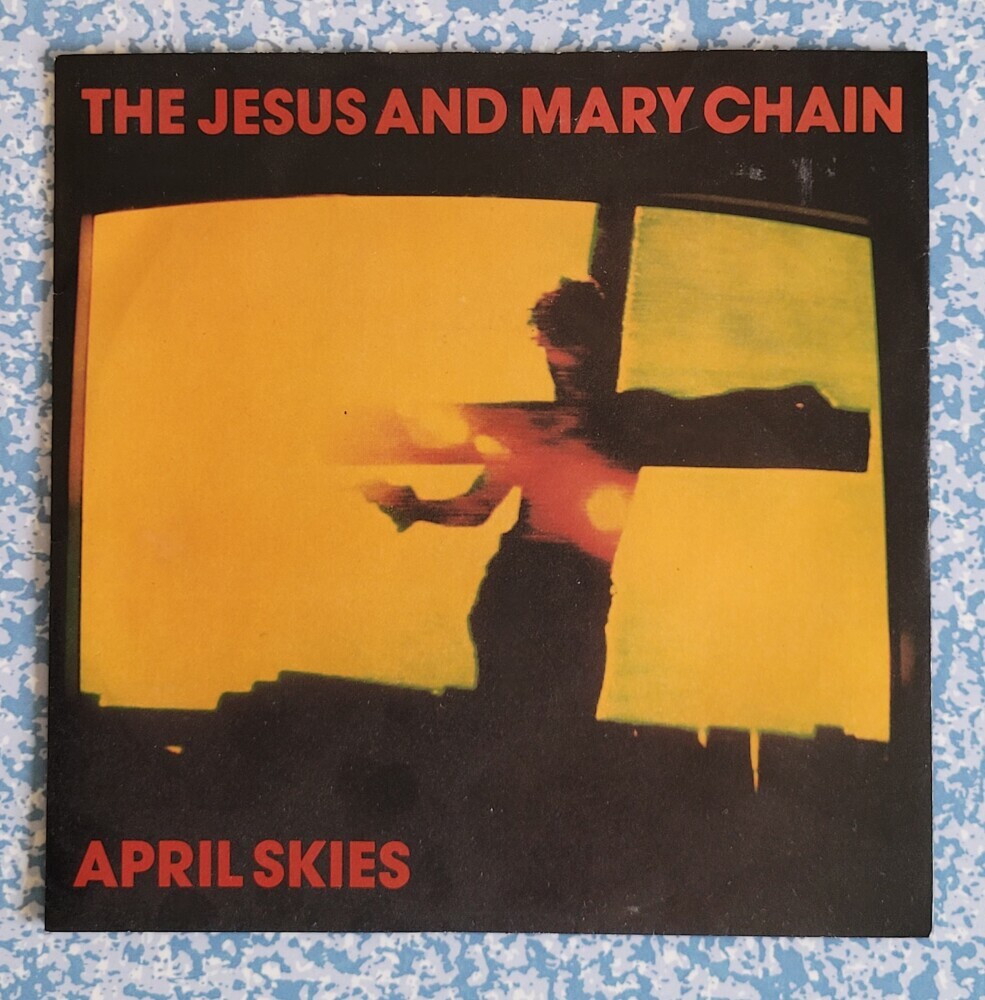
This track is the subject of a possibly apocryphal memory of sixth form. One day I had put it on the jukebox in the sixth form common room, sorry refectory. The trouble was that no-one else liked it and I was told so in no uncertain terms. Not being of a stiff enough constitution, I upped and left vowing never to return. Which, in fairness, I did not.
So, my course was set for the last twelve months or so of sixth form. I wandered lonely as a cloud (Stop it! Ed.), between record shops and bakeries every lunchtime. At break time, I would arrive early to my next lesson and wait for the rest of the class to arrive. It was purgatorial, my last year or so at sixth form.
The single entered the UK singles chart at the beginning of May 1987. It quickly made the top ten, before disappearing off the chart radar after just 6 weeks. I bought it on 27 June 1987 because I could. Of all the records in my collection, it’s just possible that this is my favourite.
Level 42 – Running In The Family
Here we have yet another contrast. This time, we flip away from the dark, brooding presence of The Jesus and Mary Chain towards the epitome of funk that is Level 42. Bought on 12-inch on 20 February Running In The Family is a pure pop track with a catchy bassline and upbeat rhythm.
In discussing 1986’s Lessons In Love, I mentioned that Level 42 were proper musicians. They had a tightness as a unit highlighted by Mark King’s distinctive slap bass technique. Taken from the album Running In The Family, this track reflects on family dynamics and the traits passed down through generations, blending personal anecdotes with universal themes.
The overriding message is one of reflection and understanding, encouraging listeners to appreciate the complexities of familial relationships and the shared experiences that shape our identities.
Simple As That by Huey Lewis & The News
Last year, I bought a clutch of singles by Huey Lewis & The News. Like most people on this side of the Atlantic, I had been introduced to the band by The Power Of Love, which of course had been featured in the film Back To The Future.
This year, they only released this single. It had a show-tune vibe to it. This made it a feel-good, easy-going tune. And, with me being a feel-good, easy-going guy (😉), I bought it. Sometimes, you just need something straightforward and catchy to brighten your day, and Huey delivered.
As usual in the UK, chart performance was a little underwhelming and it reached only number 47 in the UK singles chart. Shame.
Marillion – Incommunicado
Taken from the album Clutching At Straws, Incommunicado is a high-energy rock track that combines driving guitar riffs with Fish’s powerful vocals. It’s a great track with similarities to The Who, from Mark Kelly’s keyboards to Fish’s Daltrey-like vocals.
The song’s is marked by its fast-paced tempo and dynamic instrumentation, creating an anthemic feel. Exploring themes of fame and isolation, it captures the paradox of being in the public eye while feeling disconnected from reality.
Overall, the message is meditative, highlighting the challenges of maintaining authenticity and personal connections in a world dominated by media and celebrity culture.
I bought my 12-inch copy on 25 June 1987. Incommunicado was a top-ten hit for the band, albeit spending just 2 weeks there in a total of 5 weeks in the UK singles chart.
Full Metal Jacket (I Wanna Be Your Drill Instructor) by Abigail Mead & Nigel Goulding.
I Wanna Be Your Drill Instructor is a single from the soundtrack of the film Full Metal Jacket, directed by Stanley Kubrick. The song was credited to Abigail Mead and Nigel Goulding.

Abigail Mead was the nom de plume of Kubrick’s daughter Vivian. She composed the score for the film, and I Wanna Be Your Drill Instructor was part of this soundtrack. Nigel Goulding collaborated with her on this track.
R. Lee Ermey played a significant role in the film as sadistic drill instructor Gunnery Sergeant Hartman. His performance was highly acclaimed, and he was known for his authentic portrayal, which was partly due to his real-life experience as a Marine drill instructor. His voice and character were integral to the song, as it features samples of his iconic drill instructor commands and phrases.
I’m not sure why, but I bought this on both 7-inch and 12-inch formats. The 7-inch was, I presume the radio edit – i.e. safe enough that Mike Read wouldn’t seek to have it banned. The 12-inch version featured 2 longer versions. These were the Eskimo Pussy Mix and the Eskipo Mussy Mix. I leave you to draw your own conclusions vis-à-vis Mike Read and those.
Mel & Kim – FLM and Respectable
Let’s put my posturing about all things SAW aside for a moment. I must have loved Mel & Kim because whether on 12-inch or 7-inch I bought every one of their four single releases.
FLM by the pair is a lively pop track that showcases the duo’s signature upbeat sound. The song’s musicality is driven by its catchy melody and danceable rhythm, featuring a blend of electronic and pop elements.
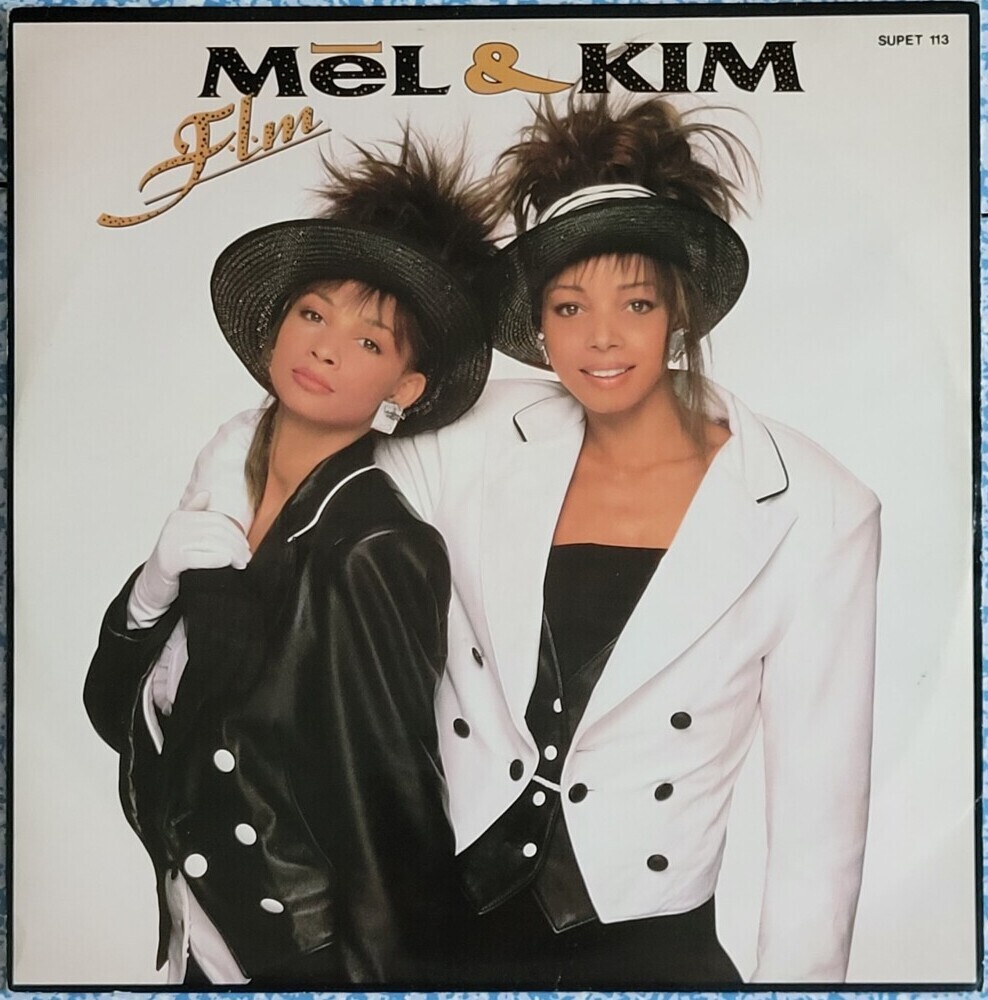
Lyrically, it stands for “Fun, Love, and Money” – a refrain repeated throughout. It’s all about capturing the aspirations and desires of young people seeking excitement and success. The track’s message is one of empowerment and ambition. It encourages listeners to pursue their dreams with confidence and enthusiasm, while also enjoying the journey along the way.
I bought FLM on 1 August 1987. It was just starting to slide down the chart after reaching its high point of number 7.
Respectable is a dance-pop anthem known for its infectious beat and empowering lyrics. The song’s musicality is characterised by its upbeat tempo and catchy hooks, making it a staple of 1980s pop music.
In many ways, it challenges societal norms and expectations, advocating for self-respect and individuality. The track’s message is one of defiance and confidence, encouraging listeners to embrace their uniqueness and stand up against judgment and criticism, ultimately celebrating personal freedom and self-expression.
Respectable came into my possession on 21 March 1987 and a week afterwards it enjoyed its one week at number one. In total, it spent 7 weeks in the top ten of the UK singles chart.
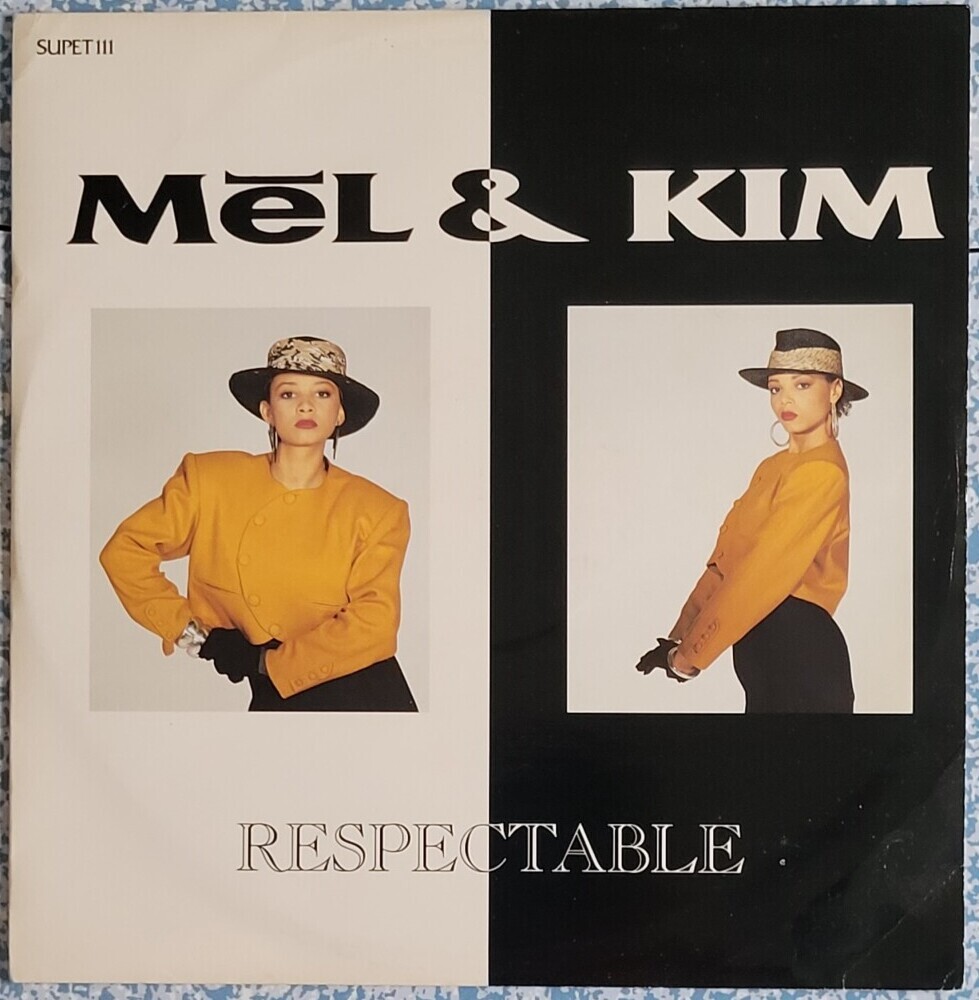
On one hand, the pop music industry has forever been like this – see The Monkees. But this is all comes across as a little peculiar. I’m sure there’s nothing untoward in all of it. But it’s three thirty-something men living their best lives, writing songs for youngsters to perform. Kids like Mel & Kim, Kylie, Jason Donovan, Rick Astley and others. Or is it jealousy on my part? Yep, probably jealousy.
Live It Up by Mental As Anything
This was another film tie-in. It was first released in Australia in 1985, where it reached number 2 in the Kent Music Report singles chart. The film Crocodile Dundee was released in the UK in December 1986. Live It Up followed, hot on its heels, with its release in January 1987. I bought the 7-inch version on 25 February 1987.
It’s an upbeat, joyful track. It’s also more one-dimensional than Zod, Ursa, and Non in the Phantom Zone in Superman 2. But who cares? It put a smile on my and many other people’s faces. It screamed good vibes and fun times.
Gary Numan’s Cars (‘E’ Reg Model)
Cars is a quintessential track that helped define the sound of new wave and electronic music in the late 1970s and early 1980s. It was the full futuristic, synth-driven experience.
Released as a single from his debut solo album, The Pleasure Principle, it became an instant success, reaching number one on the UK singles chart and breaking into the top ten in several other countries, including the United States.
It has Numan’s distinctive synthesizer riff, minimalistic lyrics, and a driving (see what I did there?) rhythm that captures the essence of the burgeoning electronic music scene. Of course, it is notable for its pioneering use of synthesizers, particularly the Minimoog and Polymoog. Both of which were central to Numan’s sound.
Lyrically, the track reflects themes of isolation and alienation. The car is a metaphor for personal space and protection from the outside world. This touched a nerve with audiences in late 1979.
The 1987 version that I bought is a remix of the original, bringing it up to date as it was introduced it to a new generation of listeners and club-goers. I was not so much a member of that new generation as I loved the original, and in 1987, I had not yet ventured into a nightclub.
As much as anything, this re-release was as much to capitalize on Numan’s enduring popularity and the song’s continued relevance. The re-release was essentially a remixed version of the track, which Many Numan purists prefer this version to the original.
This version maintained the original’s iconic elements while updating the production to fit the evolving musical landscape of the late 1980s. The 1987 re-release helped cement Cars as a timeless classic, ensuring its place in the pantheon of influential electronic music tracks.
It remains a significant cultural text, illustrating the transition from traditional rock to electronic music. It has considerable influence. Artists in the spectrum from Trent Reznor via Marilyn Manson to Dave Grohl cite Numan, and Cars, as influences.
Alexander O’Neal – Criticize
Here we go again, with a choice from way out in left field. Criticize by Alexander O’Neal is a funk-infused R&B track with a catchy groove and smooth vocals. It was the second single from his second solo album, Hearsay.
Criticize has a rhythmic bassline and dynamic arrangement, creating an engaging and danceable sound. It addresses themes of judgment and self-worth, challenging the negativity and criticism faced in relationships. The overall message is one of resilience and self-empowerment. Don’t listen to criticism, rise above it and embrace your true self.
Criticize reached number 4 in the UK singles chart in the winter of 1987.
Labi Siffre – (Something Inside) So Strong
I knew about Labi Siffre because as a big fan of Madness, I knew that he was the writer of their 1981/2 top-ten hit It Must Be Love. Consequently, I heard (Something Inside) So Strong and fell in love with it. I bought the 12-inch version on 22 June 1987. Its highest chart position was number 4 which it achieved in May 1987.
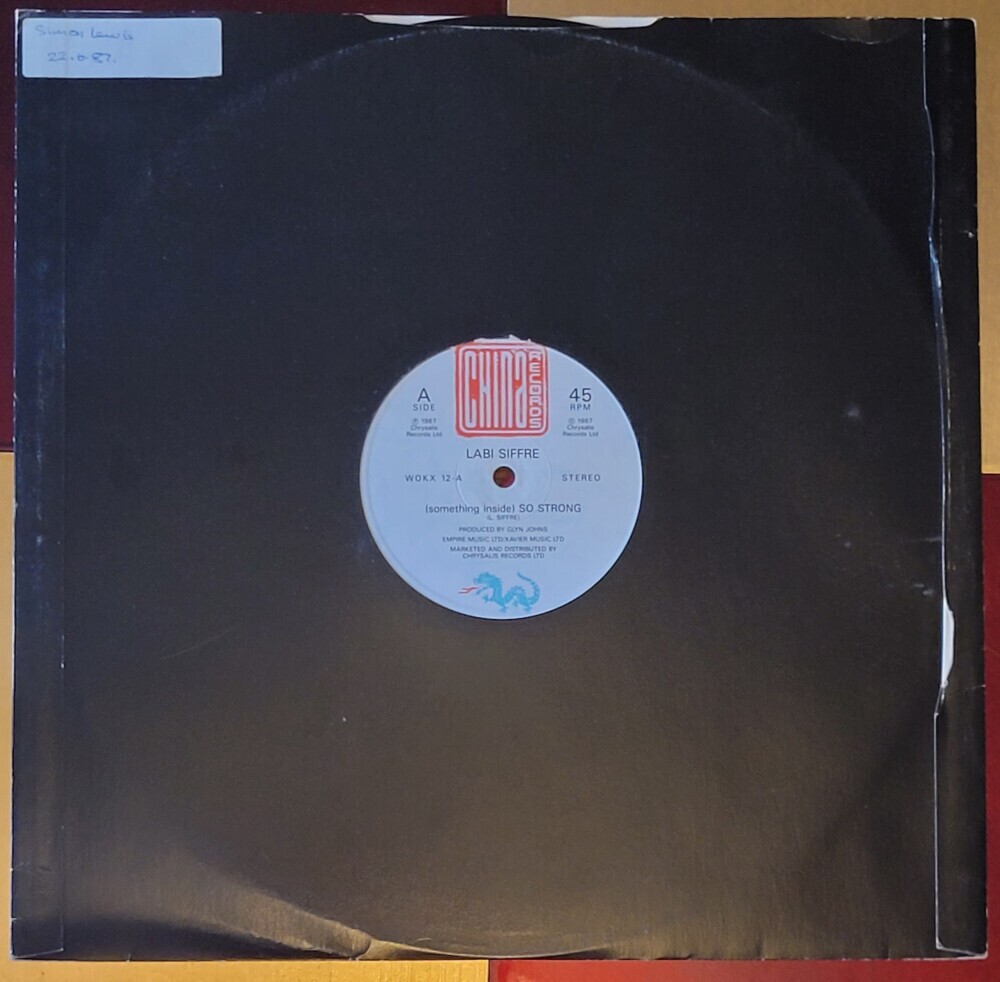
It’s an inspirational ballad with a powerful message and soulful delivery – Siffre’s melody is emotive and his vocals heartfelt. It addresses themes of resilience and inner strength. It has two sources of inspiration.
The first was a 1985 television film from Apartheid South Africa showing white soldiers shooting black children. Then, his personal experiences with discrimination as a homosexual also fed into the song.
Accordingly, the track’s message is one of empowerment and determination, encouraging listeners to overcome adversity and stand firm in their convictions. Ultimately, it’s a celebration of the unyielding spirit of the human soul.
Hourglass by Squeeze
There is no doubt in my mind that Chris Difford and Glenn Tilbrook, the songwriting team behind Squeeze, are underrated geniuses. When this was released, they had been around for 14 years. This was either as Squeeze or for a brief hiatus, between 1982 and 1985, just Difford and Tilbrook.
I bought the track on 12-inch, a little later than 1987. I did a little crate digging in the Liverpool University Students’ Union and came up with this. I paid the princely sum of one GBP and fifty pence.
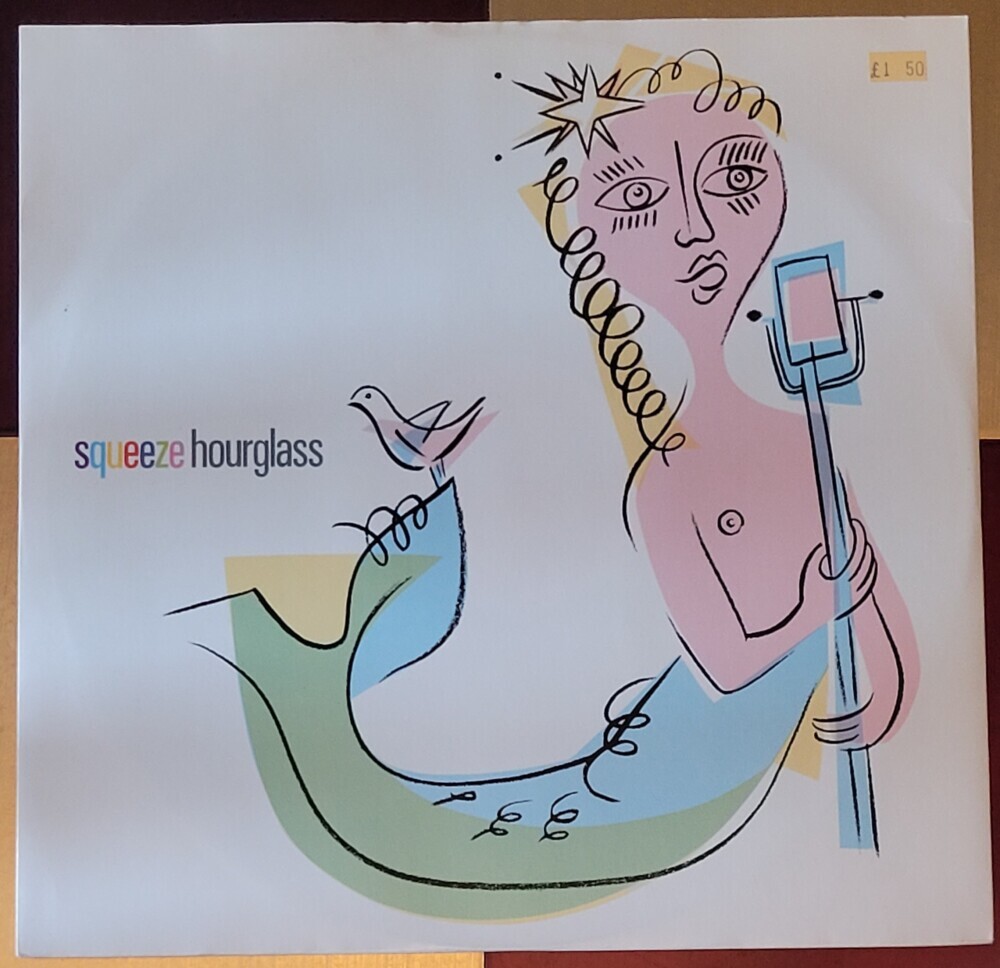
Hourglass is the first track from their seventh album, Babylon And On. Glenn Tilbrook describes it as a song that “doesn’t mean much.” It has a chorus of “nonsense lyrics,” says Difford. No matter, with a swanky video directed by Ade Edmondson it received heavy airplay on MTV and became the group’s biggest-selling single in the US. It reached number 15 on the Billboard Hot 100. This was one place better than in the UK singles chart.
It’s a pop-rock track known for its catchy, pacey melody and, critics might say, clever lyrics. The song’s musicality is drawn from its upbeat tempo, which creates a sense of time running out. The lyrics reflect this, especially the chorus which is delivered rapidly, “Take it to the bridge, throw it overboard, see if it can swim, back into the shore…”
The hourglass helps us metaphorically explore themes of time and change, reflecting on the fleeting nature of life and relationships. If it has a message, perhaps it is one of reflection and acceptance. With listeners encouraged listeners to appreciate the present moment, we are reminded that we should embrace the inevitability of change. Live life to the fullest.
The 12-inch version is perhaps a bit of a letdown. There is no live track or other fancy treatment to the song. No, the version of Hourglass offered here is the same as the 7-inch. They have merely added another track, Splitting Into Three, to the 7-inch lineup of Hourglass b/w Wedding Bells. Splitting Into Three and Wedding Bells are extra tracks on the UK CD version of Babylon And On.
Stock Aitken & Waterman – Roadblock
The impact of these three gentlemen with their slick, production line-type approach cannot be underestimated. Yes, Berry Gordy’s Motown was a slick, production line-type approach, but that facilitated the likes of Stevie Wonder, Smokey Robinson, Diana Ross, Marvin Gaye, Mary Wells and others. My point is, how many of SAW’s acts can be considered in the same light as those great artists?
But anyway, enough of my trying to be edgy with my comments about SAW. The fact is I bought several records by SAW acts. And another fact is that I bought their own offering, Roadblock.
Of course, it’s very much of its time. I know this because I have just listened to it. So that tells a tale. It was supposedly written in response to “some of the more trendy music press who usually derided any SAW release.” Not, necessarily something that you need to say if you’re thick-skinned enough.
Anyway, it’s a funky, bass-driven groove. It’s perhaps not wholly synonymous with their other works, but they did have a distinctive production style. I must have enjoyed it at the time, or else I wouldn’t have forked out for it. It was popular enough too with the rest of the British record-buying public as it reached its highest position of 13.
The Stranglers – All Day And All Of The Night
The Stranglers. Been there, done that. They were perhaps more of a seventies and early eighties phenomenon, with 3 top-ten hits in 1977 – Peaches, Something Better Change and No More Heroes. Of course, their biggest hit was 1982’s Golden Brown which reached number 2. This was not my first Stranglers’ purchase as I had sent Mum into town to buy 1984’s Skin Deep.
This one is, obviously, a cover of the Kinks’ 1964/5 classic All Day And All Of The Night. My 12-inch copy has a remixed version called the Jeff remix. In addition, there is ¡Viva Vlad! and a live rendition of their 1980 single Who Wants The World? which was recorded at the 1987 Reading Festival.
The Stranglers bring a punk rock edge to the Kinks’ classic. This is afforded by its driving guitar riffs and energetic tempo. The sound is raw and powerful, albeit with a bit of twiddly stuff. It is a remix, after all.
The lyrics are true to the original, therefore it maintains the original’s themes of desire and infatuation, expressing an intense longing for a loved one. Its message is one of passion and urgency, capturing the all-consuming nature of love and attraction, while the Stranglers’ interpretation adds a gritty and rebellious twist to the timeless classic.
U2 – Where The Streets Have No Name and I Still Haven’t Found What I’m Looking For
Building from 1984’s iconic album The Unforgettable Fire, in 1987, U2 released The Joshua Tree. In total, the band gave UK releases to four tracks from the album. I passed up on the first single, With Or Without You, but I bought the next two – Where The Streets Have No Name and I Still Haven’t Found What I’m Looking For, both on 12-inch. All three were top-ten hits in the UK singles chart.
Born out of punk but, in their early days, more new wave than anything, by 1987 U2 were stadium giants. Where The Streets Have No Name builds slowly, all ethereal organs before The Edge’s guitar begins to set the pace. Then, the full instrumental ensemble is present before Bono’s vocals start at 1:46 minutes.
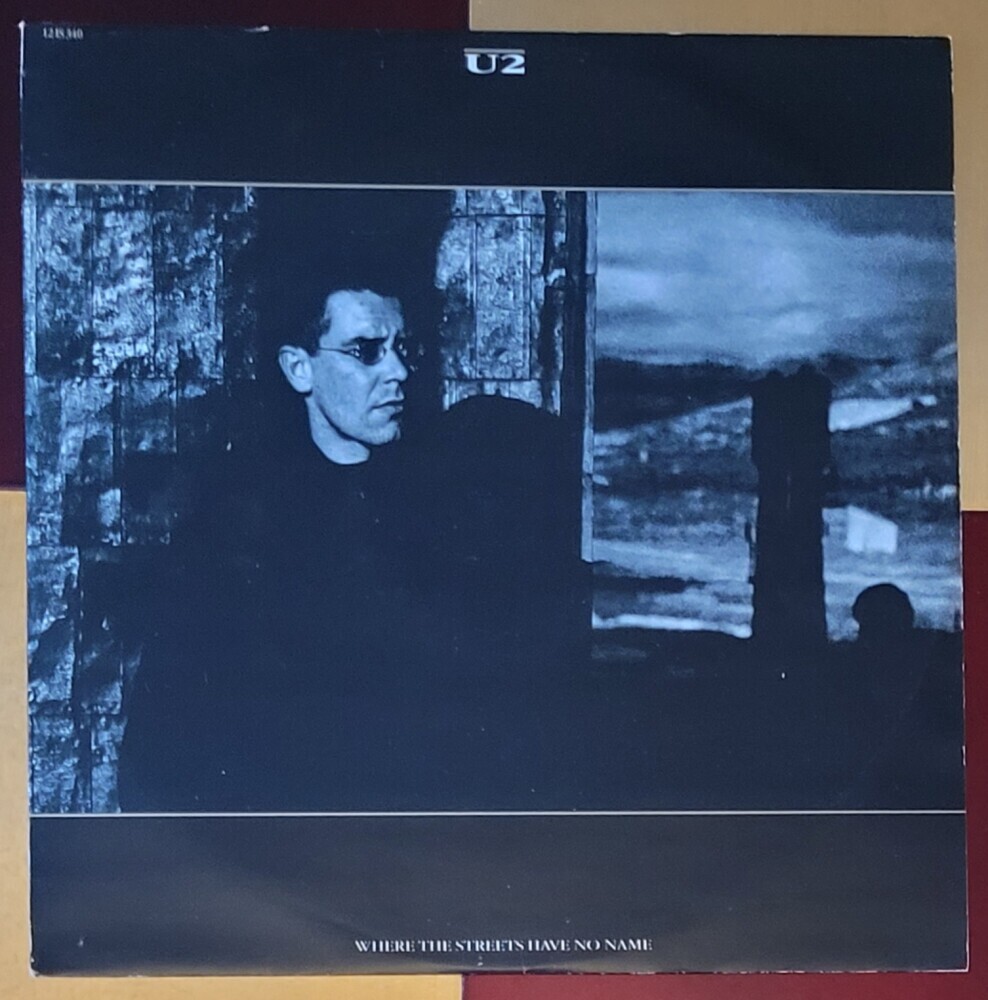
It’s an anthemic rock track with soaring guitar riffs and atmospheric sound. The song’s musicality is generated by its layered instrumentation and dynamic build-up. The listener feels a sense of grandeur and anticipation.
Lyrically, it explores themes of longing and transcendence, envisioning a place free from societal constraints and divisions – Bono had Belfast in mind when he wrote the lyrics. Where you lived was a pretty good indicator of your income and religion. Consequently, the track has a message of hope and unity. It encourages listeners to seek a deeper connection with the world and each other, ultimately celebrating the possibility of a better future.
I Still Haven’t Found What I’m Looking For is a more soulful rock track combining gospel influences with soul-searching lyrics. The song has an uplifting melody and Bono’s emotive vocals create a sense of yearning and spiritual quest.
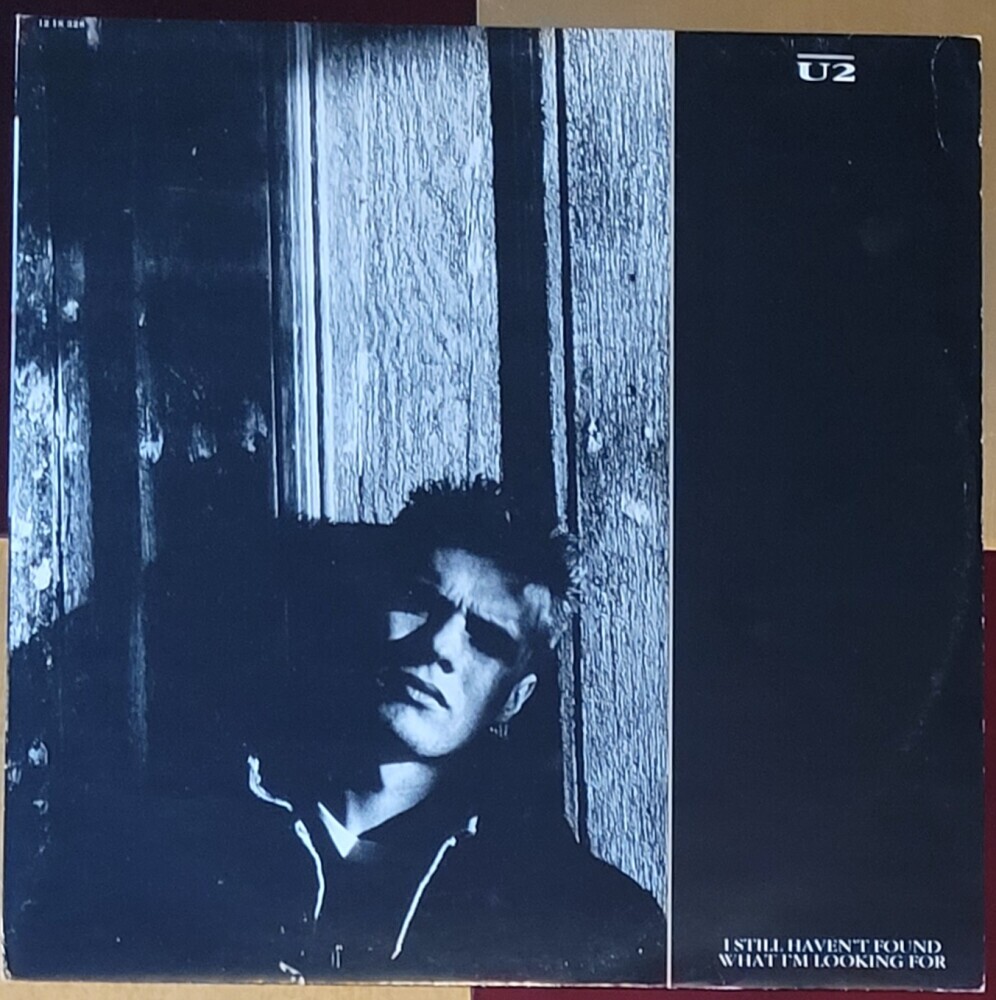
Lyrically, it explores themes of searching and self-discovery, capturing the universal human desire for meaning and fulfilment. The song conveys a journey through various experiences and emotions, highlighting themes of spiritual longing and the quest for fulfilment. The narrator describes climbing mountains, running through fields, and scaling city walls, all in pursuit of something elusive.
He has achieved certain milestones and experiencing moments of love and faith, yet still feels a sense of incompleteness and a desire for something more profound. The lyrics capture a universal human experience of seeking purpose and meaning beyond the tangible. That said, it is an uplifting track, with a message of perseverance and faith.
Maybe it’s a nod to Bob Marley’s Waiting In Vain. Life is a journey. Perhaps there’s a lot to be said for embracing the beauty of the search itself, instead of treating it as a means to an end.
| Track Listings | |
| Where The Streets Have No Name | I Still Haven’t Found What I’m Looking For |
| A1 – Where The Streets Have No Name A2 – Race Against Time B1 – Silver And Gold B2 – Sweetest Thing | A1 – I Still Haven’t Found What I’m Looking For B1 – Spanish Eyes B2 – Deep In The Heart |
UB40 – Maybe Tomorrow
This is a cover by UB40 of the Jackson 5’s minor US hit from 1971. Written by Berry Gordy, Freddie Perren, Alphonzo Mizell and Deke Richards, UB40 give it a dose of reggae. Consequently, it has a laid-back vibe, to enrich the message of its already reflective lyrics.
Musically, it is characterised by its smooth bassline and relaxed tempo, creating a mellow and soothing sound. It explores themes of hope and uncertainty, contemplating the possibilities of the future and the potential for change.
Optimism is the track’s overriding theme. With this comes patience, all things come to those who wait, especially if they believe. Resilience and adaptability are enhanced by optimism; life’s challenges are more easily borne.
Jackie Wilson
Finally, there are two posthumous releases from the fabulous Jackie Wilson. two Lastly, Firstly, Reet Petite (The Sweetest Girl In Town) was actually a 1986 re-release. I bought the 7-inch version in March 1987. It must still have been selling well as I have mine in a white paper sleeve as opposed to the proper, printed one.
This was the Christmas number one in 1986, knocking The Housemartins’ Caravan Of Love out of the way to claim the accolade. It’s the one with the clay animation video.
This too had the hand of Berry Gordy. It was written by a team consisting of Gordy, his sister Gwen Gordy, and Wilson’s cousin Roquel “Billy” Davis. Its original release was in 1957 when it reached number 6 in the UK singles chart. Despite it not selling so well in the US, this UK success aided Gordy in setting up Motown in 1959. The title was taken from a 1948 track Rete, Petite and Gone.
It really is a gorgeous slab of pure, unadulterated joy. Wilson’s energetic performance and its infectious rhythm made it a classic that was, is and shall always be. It’s hard to resist.
I Get The Sweetest Feeling
Coming hard on the heels of Reet Petite was this one. This was the track’s second re-release in the UK. It was originally released in the US in 1968, but not in the UK. It’s first UK release was in 1972 when it reached the top ten. Upon its re-release in 1975 it reached number 25. I bought this one on 12-inch on 24 April 1987 – the same day that I bought TTD’s If You Let Me Stay.
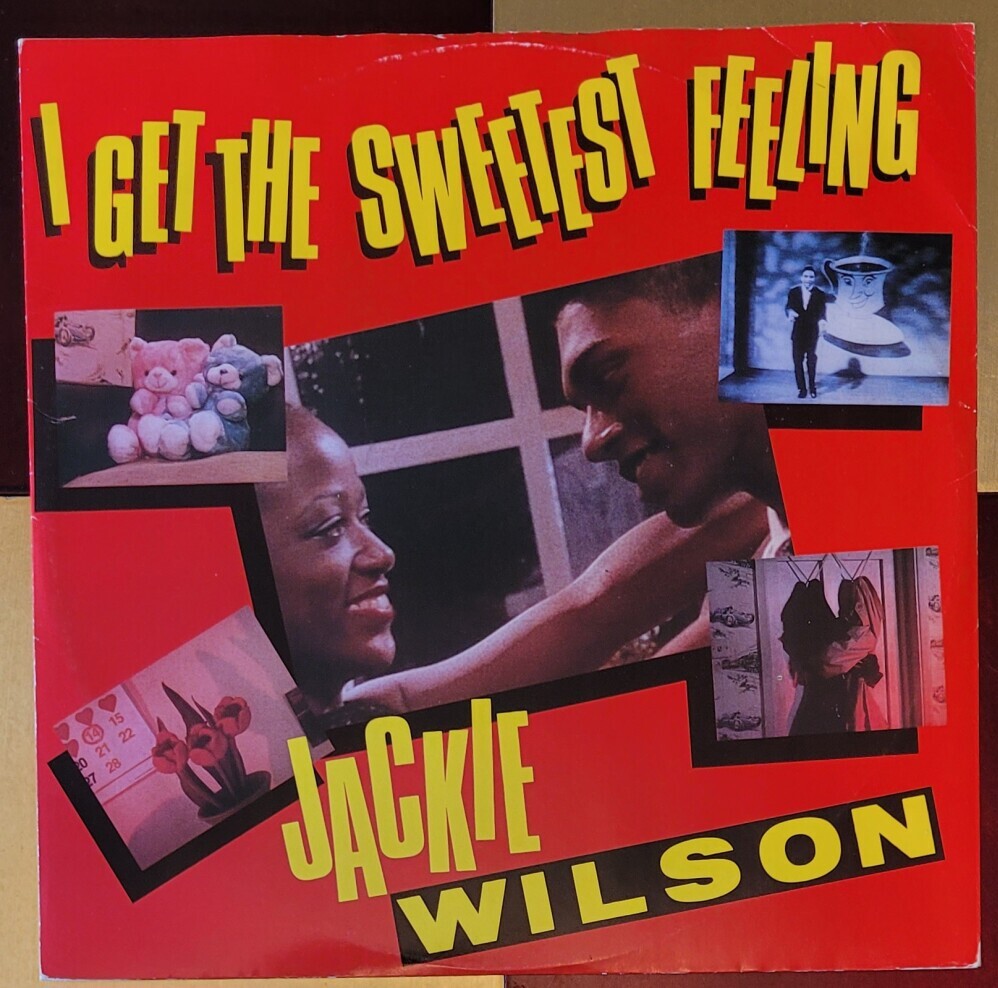
Like its predecessor in the eighties UK singles charts, it’s a classic soul track with an upbeat tempo and joyful melody. The song’s musicality is helped along by its lively brass section and Wilson’s charismatic vocals, creating an infectious and feel-good sound. It hooked me from the start with the tinkling piano intro which gives way to the drum fill before the tune proper.
Lyrically, it celebrates the euphoria of being in love – the sweetest feeling. It captures the excitement and happiness that comes with a romantic connection. The track’s message is one of joy and appreciation, encouraging listeners to cherish the sweet moments of love and embrace the positive emotions it brings, ultimately celebrating the timeless power of love.
Impact and Influence of the Tracks of 1987
The legacy of the British singles chart from 1987 is evident in the continued influence of its key songs on contemporary music. Artists today draw inspiration from the sounds and styles of this era, while nostalgia and retro trends keep the music of 1987 alive in popular culture. Whether through covers, samples, or playlists, or production techniques, the songs of 1987 continue to find favour with new generations of listeners.
Take the digital advancements that started to gather pace. Sampling and electronic elements used by artists then are now foundational in genres like hip-hop and EDM today. The techniques used in 1987 allowed modern producers to create complex layers and textures.
Then there’s the genre cross-pollination. Perhaps the scene was set here in 1986 with Run DMC’s cover of Walk This Way. In 1987, we saw artists blending pop, rock, soul, and electronic elements back then, helping to develop the trend towards today’s genre-fluid music scene. The bold experimentation of artists from the time have helped to encourage the freedom and creativity we see now.
Many current artists draw direct inspiration from the sounds of 1987. We often hear references and samples in today’s hits – Rick Astley’s Never Gonna Give You Up and its massive resurgence is a prime example – have you ever been Rick rolled? It’s become a cultural touchstone, bridging the gap between generations.
The influences of strong, unique voices like Whitney Houston’s continue to inspire vocalists today. Her powerhouse performances set a benchmark for vocal excellence. Similarly, innovative sounds from artists like Gary Numan still spark inspiration in electronic and synth-pop music.
In turn, Numan cites John Foxx era Ultravox, especially 1978’s Systems Of Romance, as an influence on him. Admittedly, it can be said of any particular year, but 1987 is pivotal in this regard.
Even the way music is consumed has roots in the practices from 1987. The idea of single releases and limited-edition packs with the associated anticipation is mirrored in today’s music drops. Platforms might have changed, but the excitement of new music hasn’t.
Overall, the musical landscape of 1987 was a rich tapestry of innovation, influence, and unforgettable hits. The legacy of that year’s music remains embedded in the heart of modern music, reminding us of a time of exciting change and creative boldness.
The songs of 1987 which dominated the charts were there for a myriad of reasons. Primarily, they were great tracks, but also, they mirrored the social and cultural trends of the late 1980s. This period saw significant technological advancements in music production and distribution, which helped shape the sound of the era. The fusion of different musical styles and the rise of iconic music videos played a crucial role in defining the decade’s musical landscape.
